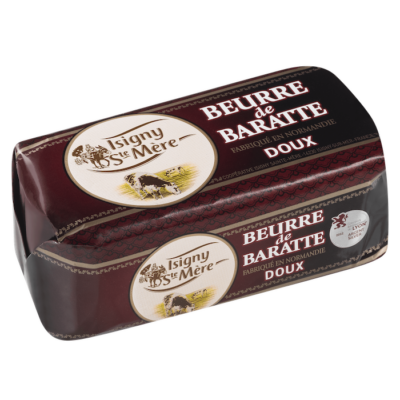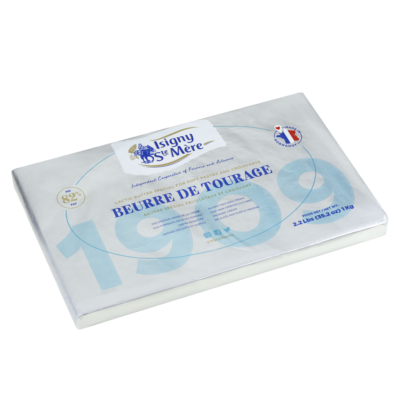What makes Isigny Butter so distinctive? First and foremost, its local region. The vast “hedged garden” that is the Baie des Veys emerged during the Tertiary Period when the waters of the Channel flooded inland, giving rise to an exceptional terroir… Our Isigny terroir.
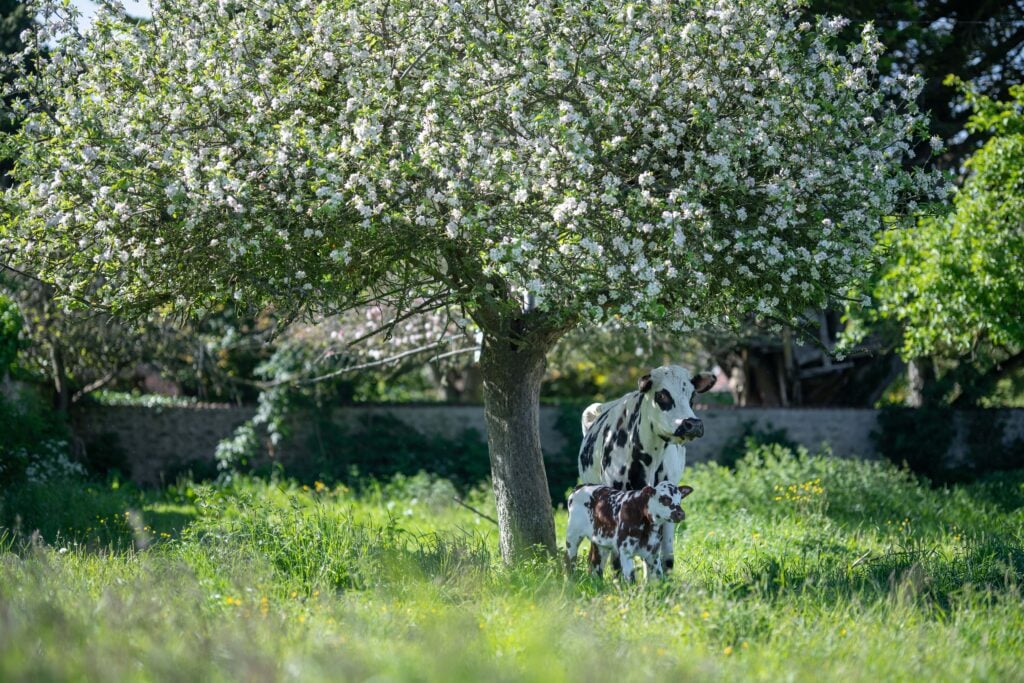
Even today, the marine-based soils, exposed to the ocean spray, benefit from a mild and temperate climate conducive to the growth of grass that is naturally rich in mineral salts, iodine and beta-carotene…
Properties that are found intact in the milk and, consequently, in Isigny Butter. Our butter’s reputation for excellence dates back to the end of the 16th century, and is the result of traditional know-how that our master butter-makers have kept alive to this day, to bring you an Isigny Butter with a truly authentic taste.
Discover all the secrets of our world-famous butter here…
Savour the taste..
The history of OUR Butter
The first traces of butter date back to the Vikings. As farming people, Scandinavians consumed large quantities of dairy products, including butter, which they spread generously onto bread.
Unable to live without this creamy product, they even took it with them on their expeditions.
The oldest traces of butter production and marketing in the Isigny region date back to the end of the Middle Ages.
The town of Isigny, with its port, became the hub of this trade. The most discerning gourmets soon set out in search of the very best butter, and it was in Normandy, in the heart of our Isigny terroir, that they found it. As early as the 16th century, an edict praised the “buttercup” colour of our Isigny Butter.
It was no surprise that it quickly found its way to all the top tables and into the most prestigious residences in Paris, Tours, Orléans, and other cities.
Its fame soon spread beyond France and then Europe, even setting out to conquer the Americas! The recipe for this success was based on two ingredients: an ancestral dairy tradition and an exceptional terroir.
The booming trade of Isigny Butter
Direct access to the sea and the presence of salt works in the Baie des Veys explain the early booming trade in Isigny Butter.
In the 18th century, traders travelled all over the region to collect butter for their next shipments.In the markets, you could observe some intriguing rituals… Buyers drew a knife from its sheath, took a small piece of butter on its tip, tasted it and engraved a price on the top of the block of butter with the knife.
Other buyers followed suit, taking care to erase the previous buyer’s price with the back of their blade…
This auction process ensured that the highest bidder won the precious block of butter and the producers got a fair price for it.


From November to June, blocks of butter were shipped to Paris and Rouen by carriage or on horseback. It took 9 or 10 days to reach the capital by road.
In 1789, on the eve of the Revolution, Isigny-sur-Mer was shipping 3.9 million pounds (about 1,800,000 kg) of butter a year, including 100,000 pounds abroad: to London, Antwerp and America!
The use of butter led to the emergence of a truly global market. The large blocks were wrapped in straw to sell on market stalls, then stored in stoneware pots, covered in salt water.
In 1858, the inauguration of the Paris-Cherbourg railway line meant that the butter could reach the capital even quicker.
Defending the “Premier cru laitier de France” – France’s finest dairy product
In 1930, our precious Isigny Butter fell victim to misuse by other producers who were quick to use its name, which represented high quality.
The producers formed a union to protect the Isigny name. This union saw the creation of the Union of the Isigny Sainte-Mère Dairy Cooperatives, and also introduced the “premier cru laitier de France” (France’s finest dairy product) designation to raise the profile of Isigny Butter and prevent imitation.
For several decades, all of the Cooperative’s documents and produce carried the “premier cru laitier de France” label specific to the Bessin region, where the finest Isigny products were made.
Isigny Butter, Protected Designation of Origin

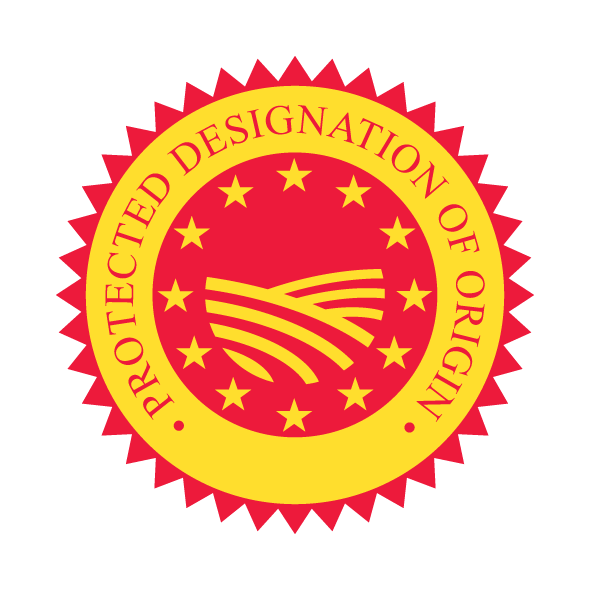
Even though the “premier cru laitier de France” label protected our Isigny Butter for some time, the battle continued into the 1980s. At this time, official recognition of the quality and the terroir of Isigny became a matter of urgency.
Many companies from all over the world were freely using our name to sell their butter. In 1984, a number of producers and processors set up a trade union to defend the producers and processors of Isigny-sur-Mer Butter and Cream.
In order to demonstrate the quality and long-standing history of our Isigny terroir products, the union asked engineering student Roger Desnouveaux to conduct a study aimed at providing evidence of the specific nature and quality of Isigny milk. The study findings demonstrated that the milk from our region and the Isigny terroir really do have specific characteristics. The cows’ diet was shown to be one of the main factors in the variations of the composition of the milk. It has high levels of beta-carotene, iodine, oleic acid and diacetyl, which give the butter its unique flavour.
This study made it possible to speed up the process of obtaining the prestigious French AOC label, with the butter finally being granted the European PDO in 1986. Our PDO Isigny Butter must therefore be produced within a precisely defined geographical area of 175 municipalities around Isigny-sur-Mer.
Producers undertake to supply and guarantee premium quality milk, and PDO Isigny Butter is packaged to weigh no more than 10 kg, with the compulsory indication of the designation of origin.
An exceptional terroir, the key to the renown of Isigny Butter
An exceptional grassland product
Like with fine wines, such as Burgundy wines, there is indeed an Isigny terroir or “climate”.
As early as 1874, livestock farmers turned the Isigny region into a prestigious grazing area described as “opulent pastures, veritable fountains of cream and butter”. An exceptional milk that is used to create a unique butter.


The region’s geographical location, with its close proximity to the sea, and its typically flat terrain, help to explain the uniform distribution of rainfall throughout the year and its mild temperatures, even in winter.
These elements encourage the growth of grass all year round and generate long grazing periods for the animals.
The soils of our terroir are rich in minerals, which makes for luxurious grassland, while the silts found in the uplands regulate the rainfall, which is also conducive to regular grass growth.
Today, the staple diet of our dairy cows comes from the meadows on which they graze for at least seven months of the year.
Producers have a particular fondness for the Normande breed, which is an excellent butter-maker, thanks to its milk that is rich in both fat and protein.
With a supply of fresh or preserved grass for consumption all year, a significant proportion of the breed can be kept in the geographical area.
A coastal terroir where soils of marine origin, combined with a mild and temperate climate, encourage the growth of grass that is bursting with mineral salts and carotenoids.

The cows here produce naturally rich milk and, as a result, butter with a unique flavour, creaminess and colour.
The yellow gold of Isigny Sainte-Mère
Butter has different forms, textures, colours and flavours.
Melted, mixed, kneaded, moulded, soft, creamy, firm, hot or cold, it can accompany all dishes and preparations and take on all shapes…
It also reminds us of the crackers or toast of our childhood.
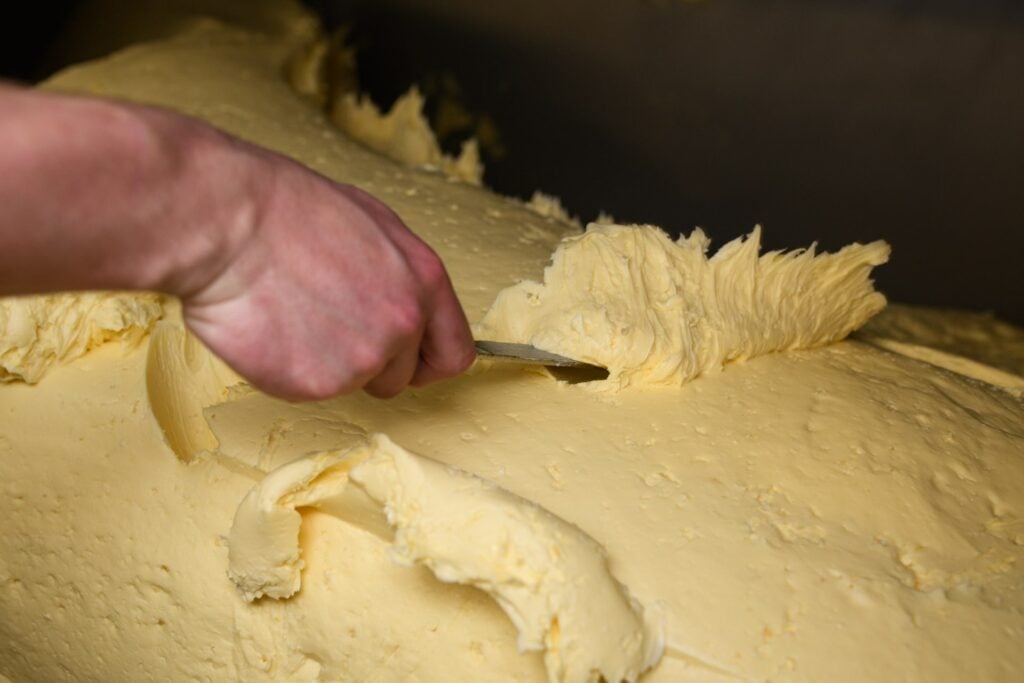
- Its texture: The quality of the pasture gives a homogeneous stable fat rich in oleic matter, which leaves our Butter with an excellent soft and creamy texture. It is very spreadable.
- Its taste: Our butter has a creamy taste and a high iodine content, which comes from the proximity of the sea, its geological history and the type of soil, which is flooded by salt water in winter.
- Its flavours: It has flavours of fresh cream and hazelnut.
- Its colour: The presence of carotenes, precursors of vitamin A, in the lush grass of the region’s pastures, produces the natural buttercup colour of our butter. The fresh spring grass gives it a bright yellow colour and a softer texture. Depending on the season, PDO Isigny Butter will therefore not have the same colour, which is a sign of fine quality.
- Its benefits for human health: Our milk has a high mineral salt content, particularly sodium, and high concentrations of micronutrients. These are substances that are essential for healthy and balanced growth. It is also a source of vitamin A, contributing to the growth of bones and teeth, and protects against infection.
The production secrets of our PDO Isigny Butter
Over the centuries, the way in which we make our Butter has changed very little. The cream is churned to form small grains of butter, which are washed with pure water and then kneaded until a smooth texture is obtained.
To obtain this texture and the flavours that are so characteristic of our Isigny Butter, we carefully select the natural fermenting agents that give it all these qualities. These are the essential stages in making Isigny Butter:
- Skimming: the milk is separated into two components: the fat and the skimmed milk. The fat must be separated from the skimmed milk.
- Pasteurising the cream: this stage eliminates the germs that are naturally present in the cream.
- Addition of lactic fermenting agents so that the Butter develops all of its flavours and specific texture..
- Churning: to transform the Cream into Butter. During this stage, repeated vigorous mixing isolates the fat globules and binds them together to form grains of butter.
- Washing: to remove the buttermilk once and for all, the butter grains are washed in pure water.
- Kneading: this stage binds the butter grains together and homogenises the product, which is then moulded and packaged.
- Salting: to obtain salted butter, fine or coarse salt is added to the butter.
The signature of the terroir… Lactic fermenting agents, essential for making dairy products…
Lactic ferment agents selected by our Master Butter-Maker are added to the preparation.
These fermenting agents are taken from their original environment, the cradle of our long-standing know-how: the Isigny farms. They come from milk of a rare quality and are the signature of the terroir, guaranteeing the unique character of our Butter.
For decades, our Isigny Sainte-Mère Cooperative has been creating cultures and breeding its own lactic fermenting agents in order to preserve the particular character and complexity of the flavours of its products.


